{Click on an image to enlarge, then use the back button to return to this page}
This page last updated on 04/13/2017
 |
| (Fig. 01) |
|
 |
| (Fig. 02) |
|
 |
Park Description: Located 15 miles west of Las Vegas, via Blue Diamond Rd., Spring Mountain Ranch State Park is in the Red Rock Canyon National Conservation Area, beneath the colorful cliffs of the magnificent Wilson Range. At an elevation of 3,740 feet, the ranch is usually 10-15 degrees cooler than the Las Vegas Valley. Today the parks’ main purpose is to preserve the historic Sandstone Ranch (Fig. 01) or Sand Stone Ranch, as it was first known when it was established in 1876. The 512-acre ranch, within the boundaries of the Spring Mountain Ranch State Park, was listed on the United States National Register of Historic Places on April 2, 1976. This old homestead has several open pastures and large lawns (Figs. 03-05) , a large shallow pond (Fig. 06), several stands of trees, and a variety of old ranch buildings. Historical Sites at the park include the Main Ranch House; Wilson Cemetery, Sandstone Cabin, Board and Batten bunkhouse (Fig. 07); Blacksmith's Shop (Fig. 08), Hay and Horse Barn/Corral (Fig. 09), Two-Hole Outhouse, Chinchilla Shed and many more. This virtual island of green vegetation and its large pond is surrounded by a sea of desert scrub that attracts a variety of birds, dragonflies and other wildlife. It has excellent, tree-shaded picnic sites (Fig. 10) that offer tables, grills and restrooms. There is a $9 per vehicle entrance fee with a $2 discount to all Nevada residents. For more info, see the section titled, Ranch History, at the bottom of the page.
|
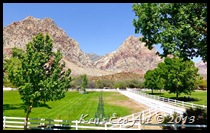 |
| (Fig. 03) |
|
 |
| (Fig. 04) |
|
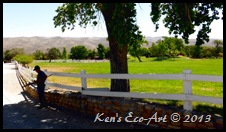 |
| (Fig. 05) |
|
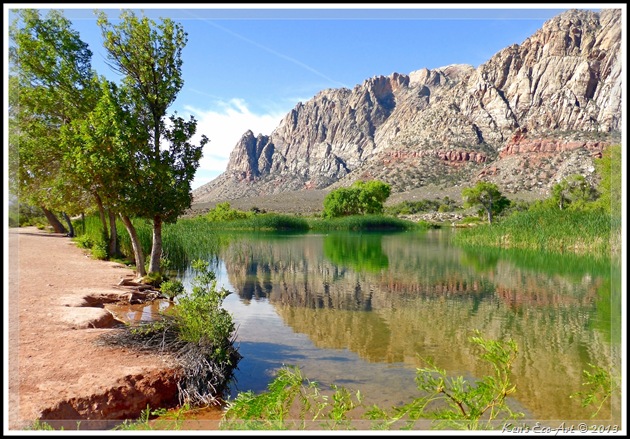 |
| (Fig. 06) |
|
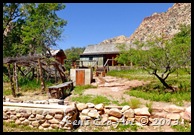 |
| (Fig. 07) |
|
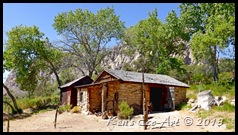 |
| (Fig. 08) |
|
 |
| (Fig. 09) |
|
|
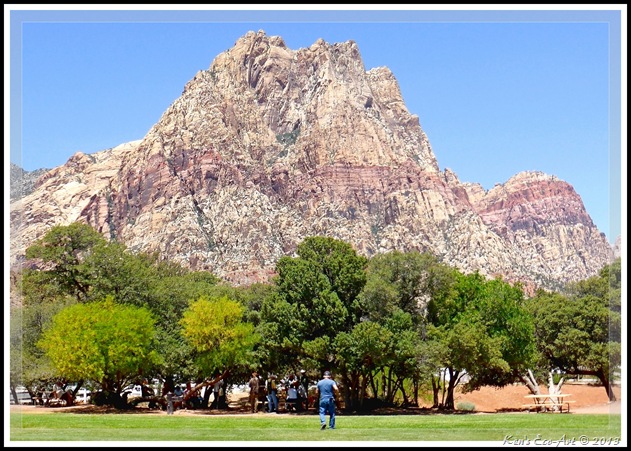 |
| (Fig. 10) |
|
|
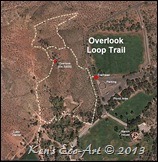 |
| (Fig. 11) |
The Hikes: There are three basic hiking trails on the property; the Overlook Trail, the Sandstone Canyon Trail, and the Ash Loop Trail.
The Overlook Trail: This .9 mile loop trail (Fig. 11) starts at the parking area, and heads north to an overlook at an elevation of 3,832 feet. It then drops down to Lake Harriet, a spring fed lake that has water year round. It then circles back down to the parking area, passing several of the ranch’s original buildings. the Follow the road to the left and walk around to the back side of the lake to see Boulder Dam Jr. This was a small electric generating station from years back. It's an historic stop now. is at an elevation of 3,832 feet.
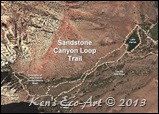 |
| (Fig. 12) |
The Sandstone Canyon Trail: This 2.2 mile loop trail (Fig. 12) starts at Lake Harriet and continues west toward Sandstone Canyon on the park's road. At the end of this road, the trail curves north and continues in a loop through the desert, back to the lake. Taking a side trail that goes into the mouth of Sandstone Canyon can add an additional half mile or more to this hike. When you enter the canyon, you're in a wash where you can either stay higher on the hill or go down into the wash where you will have to do some minor boulder scrambling up the wash. Hiking about a quarter mile up the wash will bring you to an elevation of around 4,200 feet, making the total round-trip length of this hike about 2.6 miles.
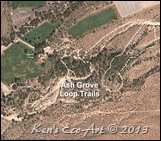 |
| (Fig. 13) |
The Ash Loop Trail: This is a nice 0.75-mile loop trail (Gig. 13) that runs east from behind the Ranch House, down a wooded gully, across a creek, past a spring, and around a big loop, passing under a number of Fremont's cottonwood, shrub live oak, pinyon pine, Utah juniper, and velvet ash trees along the way. Depending on how you walk it, there needs to be only a few yards of backtracking where you cross the creek. |
|
| 05/26/2016 Trip Notes: This was the last scheduled Spring hiking trip for the Henderson Senior Center Rock-hounds before summer. Their yearly visit was also their year-end picnic. Click here for pictures and a description of this visit ... Spring Mountain Ranch - Trip Notes for 05/26/2016. |
|
|
09/10/2015 Trip Notes: This was the first fall scheduled hiking trip for the new Fall season of the Henderson Senior Center Rock-hounds. Click here for pictures and a description of this visit ... Spring Mountain Ranch - Trip Notes for 09/10/2015.
05/29/2014 Trip Notes: This was the last scheduled hiking trip of the 2013-14 season. For what seems to have become a tradition, we all enjoyed a 'pot luck' picnic and bar-b-queue. Click here for pictures and a description of this visit ... Spring Mountain Ranch - Trip Notes for 05/29/2014. |
|
10/14/2013 Trip Notes: On Columbus Day Connie and I took some visiting company to Spring Mountain Ranch for a picnic and afternoon of hiking. Click the following for pictures and a description of this visit ... Update - Spring Mountain Ranch State Park.
05/30/2013 Trip Notes: This was the last scheduled trip of the season with the rock-hounds from the Henderson Heritage Park’s Senior Facility before knocking off for the hot summer months. Even though several of us had been here at night over the years for their outdoor summer theater performances, none of us had ever come for the daytime picnicking and hiking, and boy were we surprised. Surrounded by the Wilson Cliffs, this park is just filled with beauty. The view in (Fig. 14) is looking south towards the ranch from the top of the Overlook Trail (refer to Fig. 12) peak (3,832 feet). The next picture (Fig. 15), taken from the same spot, is looking west towards Sandstone Canyon. If you enlarge the picture by clicking it, you can see the small Wilson cemetery, original owners of the ranch. On the left, where the trail seems to split and head towards Sandstone Canyon, Lake Harriet is mostly hidden in the large stand of trees and vegetation surrounding it. Instead of completing this loop trail, most of us took a leisurely hike around the lake Harriet (Figs. 16 & 17), eventually following the old “jeep” road out to Sandstone Canyon. At the end of the road, the trail makes a wide loop and begins heading back to the lake. Less than a hundred yards past the turn, a small, less traveled trail heads due west (Fig. 18), then northward deeper into the Sandstone Canyon wash. We followed this for nearly a half mile eventually hiking down into the rocky wash itself (Fig. 19), enjoying the awesome views of the surrounding cliffs (Figs. 20 & 21) along the way. On the way back I captured a few more pictures (Figs. 22-25) along the lake that included shots of some flowering plant life, a white butterfly, a dragonfly and a duck that was resting along the edge under the shade of a large tree. While we were hiking this trail the other half of the group hiked the Ash Loop Trail and took self-guided tours of the ranch house and other ranch buildings. We then all met in the shaded picnic area (Fig. 10) for a cookout that included hamburgers, hot dogs, baked beans, two salads, homemade chocolate cake, and all the fixings. It was a great day – beautiful weather, good hiking, gorgeous scenery, great food and good company with which to share it with.
|
 |
| (Fig. 14) |
|
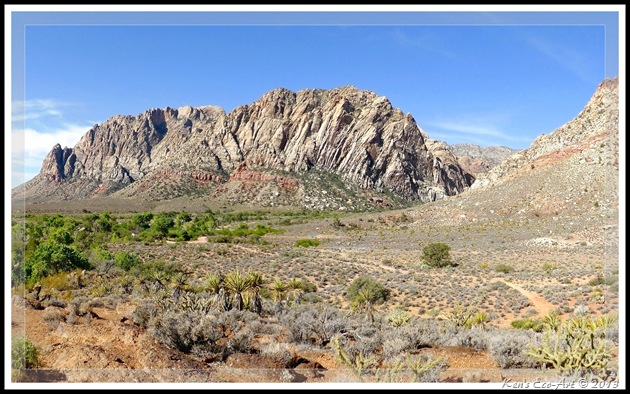 |
| (Fig. 15) |
|
 |
| (Fig. 16) |
|
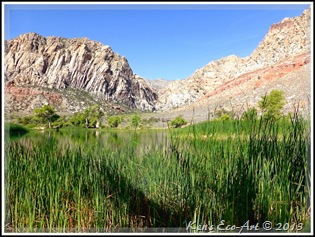 |
| (Fig. 17) |
|
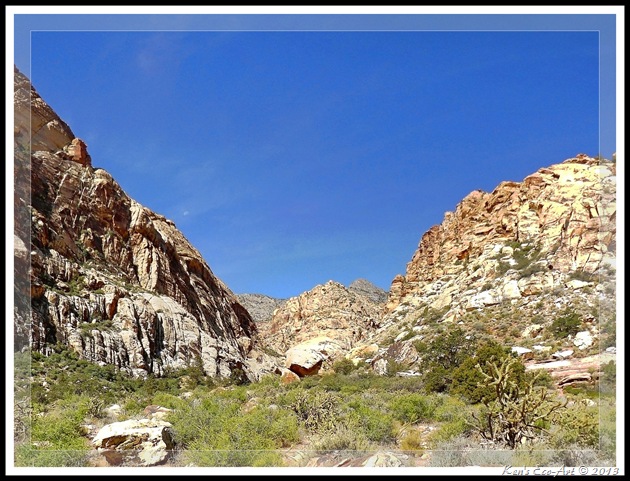 |
| (Fig. 18) |
|
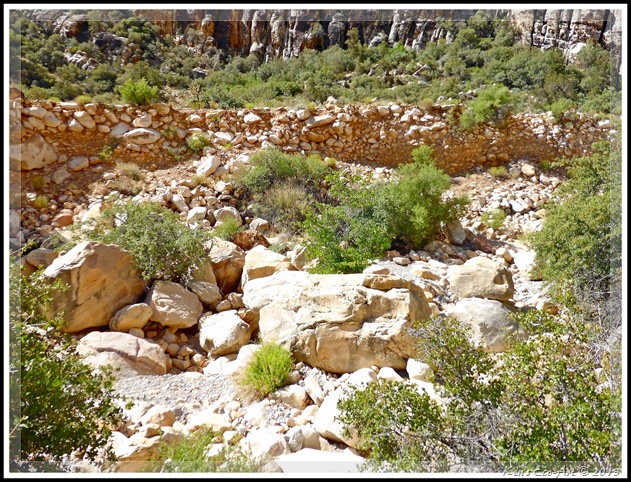 |
| (Fig. 19) |
|
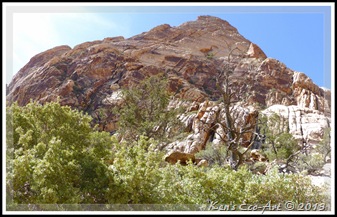 |
| (Fig. 20) |
|
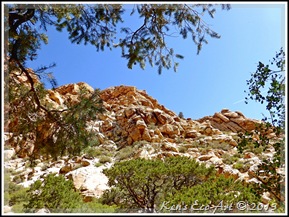 |
| (Fig. 21) |
|
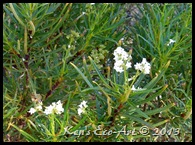 |
| (Fig. 22) |
|
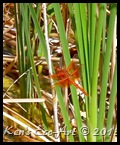 |
| (Fig. 23) |
|
 |
| (Fig. 24) |
|
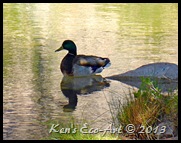 |
| (Fig. 25) |
|
Ranch History: The many springs in these mountains provided water for Paiute Indians and later brought mountain men and early settlers to the area. In the mid-1830s, a campsite was established along the wash that runs through the ranch. The spring-fed creek and grassy meadows formed an oasis for travelers using the alternate route of the Spanish Trail through Cottonwood Valley. The use of the site by pack and wagon trains continued until their replacement by the railroad in 1905. This remote trail was also used extensively by outlaws involved in Indian slave trading, horse stealing and raids upon passing caravans. In 1840, a group of American mountain men and Ute Indians conducted a famous raid on the Mexican Ranchos in California. Mountain Man Bill Williams, a member of the raiding party, brought his band of horses through Red Rock Canyon where he rested the horses from the hard trip across the desert. Apparently he revisited the area several times and for many years afterwards the site of Spring Mountain Ranch was known as the "Old Bill Williams Ranch".
In 1876, Spring Mountain Ranch was homesteaded as the Sand Stone Ranch by Jim Wilson, a former Army sergeant from Fort Mohave. In 1929, Willard George, a friend of the Wilson family, acquired the ranch by paying off the outstanding debt incurred by Jim Jr. and Tweed. George was largely an absentee owner, leaving the ranch operation to the Wilson's. During 1941-43 the George family lived on the ranch. George was a prominent furrier in Hollywood, and during this time he raised chinchillas in addition to the cattle operation.
In 1944, George leased (with option to buy) to Chet Lauck, (Lum of the "Lum and Abner" radio show). Lauck exercised his option to buy the 520 acre oasis in 1948 and renamed the property the Bar Nothing Ranch. He kept the cattle operation going but built part of the ranch into a family vacation retreat with a much expanded ranch house, a boy's camp and a large reservoir that he named "Lake Harriet," after his wife. He sold the property in 1955 to Vera Krupp, a famous German movie actress. She renamed the property the Spring Mountain Ranch. Krupp was the longest residing owner. She expanded the business of ranching by raising a large herd of a hybrid strain of white-faced Hereford and Brahma. She added a swimming pool and expanded the west wing of the main house. It was her principal residence until 1967. Some time after that, Howard Hughes owned the place for a while. Three generations of Wilson men are buried in a small family plot on the ranch. |


























